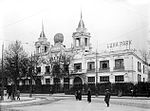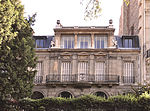Monument to the Glory of Émile Levassor

The Monument to the Glory of Émile Levassor (French: Monument à la gloire d'Émile Levassor), also known as The Triumph of Levassor (French: Le Triomphe de Levassor), is a sculpture in Paris, France, placed in the Alexandre and René Parodi Square, near Admiral Bruix Boulevard, within the 16th arrondissement of Paris. It is dedicated to Émile Levassor, an engineer and a pioneer of the automobile industry and car racing in France, and commorated him crossing the finish line first in the 1895 Paris–Bordeaux–Paris, which is sometimes considered the first automotive race in history. It was designed Jules Dalou and Camille Lefèvre, and unveiled on 26 November 1907, at the entrance to Boulogne Woodland park. In 1972 it was moved to its current location.
Excerpt from the Wikipedia article Monument to the Glory of Émile Levassor (License: CC BY-SA 3.0, Authors, Images).Monument to the Glory of Émile Levassor
Tunnel Grand-Maillot, Paris 16th Arrondissement (Paris)
Geographical coordinates (GPS) Address Nearby Places Show on map
Geographical coordinates (GPS)
| Latitude | Longitude |
|---|---|
| N 48.876628 ° | E 2.280338 ° |
Address
Monument à Émile Levassor
Tunnel Grand-Maillot
75116 Paris, 16th Arrondissement (Paris)
Ile-de-France, France
Open on Google Maps







